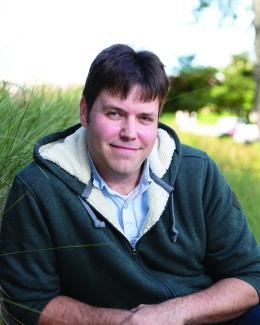Ben Doughty - Finding the right answers
June 26, 2017 — No two scientists have the same story about how they ended up in their field. Some people seem to have been born scientists; others develop their love for it as budding minds full of curiosity. Then there are those who don’t discover science until later in life, but when they do, they fall down the rabbit hole with the same interest and passion as any lifelong scientist.
Ben Doughty’s introduction to science didn’t occur until he had almost graduated from high school. He remembers sitting in a diner as a teenager with his father, hearing about the theory of relativity for the first time. The conversation led him to read Stephen Hawking’s A Brief History of Time, which piqued his interest in physics and the “odd and abstract” world of science.
“It was sort of hard to believe that all this stuff existed and that it didn’t really impact me on a daily basis but people could explain it with math,” he said.
Doughty enjoyed his chemistry classes and was motivated to delve deeper into the science and pursue chemistry research at the University of Florida, where he first encountered laser spectroscopy.
“I’ve always understood science and chemistry in a time-domain picture. That’s how my brain works,” Doughty said.
With laser spectroscopy, he said, “a whole new world opened up where I could do research and I could learn something really new that no one else had seen before.”
Doughty earned his doctorate from the University of California, Berkeley, in 2010 and went on to work as a postdoctoral scientist at Columbia University before joining ORNL in 2013 as a Wigner Fellow.
Now, Doughty is a laser spectroscopist in the Chemical Sciences Division of the Department of Energy’s Oak Ridge National Laboratory, where he uses powerful lasers to probe the chemical properties of nanoscopic and macroscopic surfaces.
Doughty’s research uses femtosecond laser pulses, just a millionth of a billionth of a second in length, to initiate and probe processes in complex materials and extract molecular structure and orientation at reactive surfaces. The lasers provide a high-definition look into how molecules bind to a surface and how electrons, holes and excitons in the material move in real time and space.
“We’re on the basic energy science side of things, so we’re studying very simple molecules on very nice, clean surfaces,” Doughty said. “Understanding these processes at a very fundamental level, though, is the framework for more advanced studies of more complicated materials.”
The resulting data takes a good deal of interpretation, Doughty said, but the information from these seemingly basic experiments can be used to understand and improve complex chemical and material systems such as catalytic surfaces and solar cells.
“You get a line on a screen, and then you have to make sense of it,” he said. “The exciting part is when you start being able to assign what those wiggles mean and assign them to visual things, to a model.”
Doughty enjoys the tinkering challenge of his work, where every element, from instrument programming to the optics, must be home-built by the researchers. He likens it to “really expensive adult Legos” that must be assembled into one cohesive unit before an experiment can function.
“There’s not a challenge that’s exactly the same as this,” he said. “There’s a level of precision you have to have here. It’s the challenge that keeps me excited about the job.”
The intricate setup is sensitive to failure and the data often takes a long time to analyze. Doughty said scientists in his line of research must possess dedication, skill and, above all, abundant patience in order to obtain the desired results.
“You have to be excited at the failures of an experiment to realize how to make the next one work better,” he said. “There’s a little bit of stubbornness, when you say, ‘I know I’m going to get this to work.’”
Doughty can’t pinpoint exactly what drives him to pursue his research and continue to innovate, but he knows the satisfaction that comes from a successful experiment can make the whole process worth it.
“When it all finally works together, it’s like you’ve actually accomplished something. You can see what’s been done,” he said. “It’s a remarkable feeling at the end of the day when you finally get the right answer.


